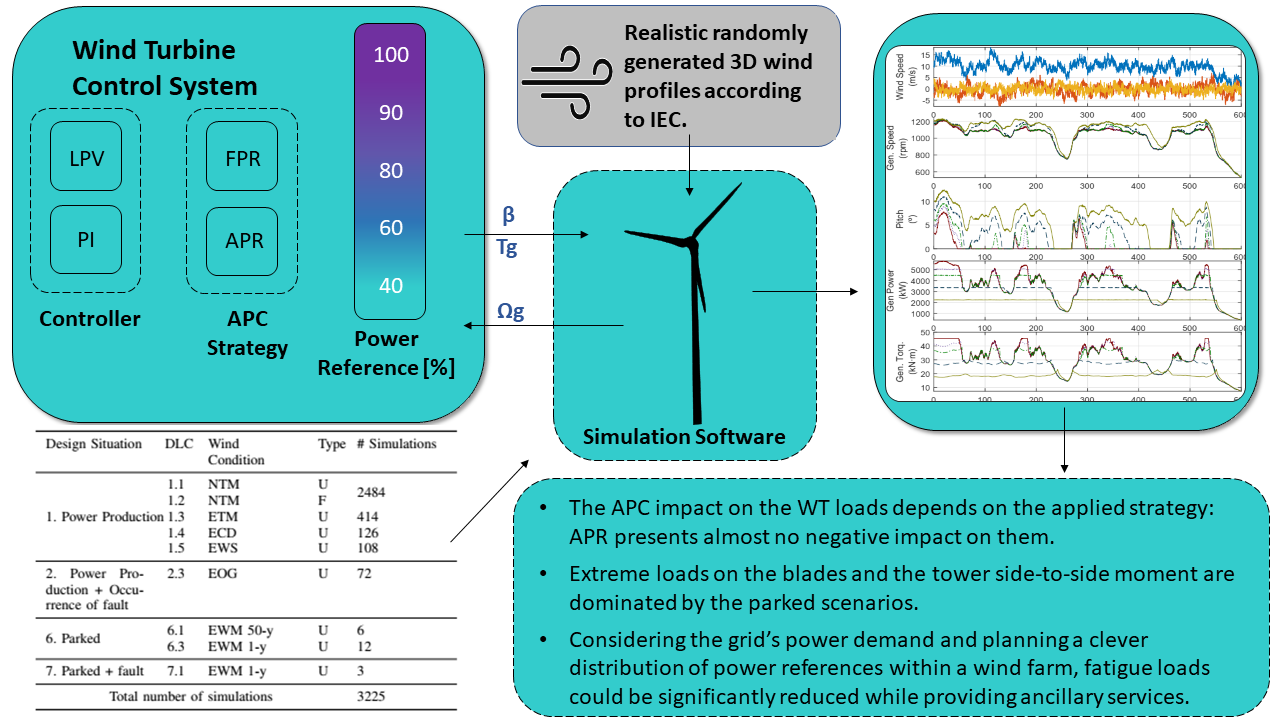Active Power Control on wind turbines: impact on mechanical loads
Keywords:
wind turbine, load analysis, active power control, power reserve control, fatigue and extreme loadsAbstract
This work focuses on the evaluation of how Active Power Control (APC) impacts the mechanical loads of a utility size Wind Turbine (WT). Two APC strategies, each with four levels of power reserve, are considered and compared. The assessment is numerically performed over the 5 MW WT benchmark model. Fatigue analysis is carried out under realistic wind profiles and following IEC 61400-1 standard. Extreme load analysis is performed as well, with extreme wind conditions as defined in the standard, and with a statistical load extrapolation from normal wind conditions. The assessment is repeated with both a Linear Parameter-Varying controller and a gain scheduling Proportional Integral controller comprising 3225 simulations. Interesting results are obtained about how APC affects mechanical loads, and how this impact changes according to the control strategy applied. For instance, for some combination of controllerscheme and APC strategy, fatigue loading is reduced with respect to maximum power tracking without increasing extreme loads. These results lead to the conclusion that fatigue load can be improved by unevenly distributing power reserve among wind turbines across the wind farm.
Downloads
References
E. Ela, V. Gevorgian et al., “Active power controls from wind power:
Bridging the gaps,” National Renewable Energy Laboratory and University of Colorado and Electric Power Research Institute, Tech. Rep.,
I. Komusanac, G. Brindley et al., “Wind energy in europe,” Tech. Rep.,
T. Castillo, F. García et al., “Panorama energético de américa latina y
el caribe,” OLADE, Tech. Rep., 2022.
E. Marinozzi and A. Lesce, “Informe anual 2021,” CAMMESA, Tech.
Rep., 2022.
F. D. Bianchi, H. D. Battista, and R. J. Mantz, “Optimal gain-scheduled
control of fixed-speed active stall wind turbines,” IET Renewable Power
Generation, vol. 2, pp. 228–238, apr 2008.
M. Vali, V. Petrovic et al., “Model predictive active power control
of waked wind farms,” in 2018 Annual American Control Conference
(ACC). IEEE, jun 2018.
H. Luo, Z. Hu et al., “Coordinated active power control strategy for
deloaded wind turbines to improve regulation performance in AGC,”
IEEE Transactions on Power Systems, vol. 34, no. 1, pp. 98–108, jan
X. Tang, M. Yin et al., “Active power control of wind turbine generators via coordinated rotor speed and pitch angle regulation,” IEEE
Transactions on Sustainable Energy, vol. 10, no. 2, pp. 822–832, apr
S. Siniscalchi-Minna, F. D. Bianchi et al., “A wind farm control strategy
for power reserve maximization,” Renewable Energy, vol. 131, pp. 37–
, feb 2019.
F. A. Inthamoussou, H. D. Battista, and R. J. Mantz, “LPV-based active
power control of wind turbines covering the complete wind speed range,”
Renewable Energy, vol. 99, pp. 996–1007, dec 2016.
Y. Yuan, X. Chen, and J. Tang, “Multivariable robust blade pitch control
design to reject periodic loads on wind turbines,” Renewable Energy, vol.
, pp. 329–341, feb 2020.
H. Coral-Enriquez, J. Cortés-Romero, and S. A. Dorado-Rojas, “Rejection of varying-frequency periodic load disturbances in wind-turbines
through active disturbance rejection-based control,” Renewable Energy,
vol. 141, pp. 217–235, oct 2019.
F. Pöschke, E. Gauterin et al., “Load mitigation and power tracking
capability for wind turbines using linear matrix inequality-based control
design,” Wind Energy, apr 2020.
B. Ibáñez, F. Inthamoussou, and H. D. Battista, “Wind turbine load
analysis of a full range LPV controller,” Renewable Energy, vol. 145,
pp. 2741–2753, jan 2020.
P. A. Fleming, J. Aho et al., “Effects of power reserve control on wind
turbine structural loading,” Wind Energy, vol. 19, no. 3, pp. 453–469,
mar 2015.
J. Jonkman, S. Butterfield et al., “Definition of a 5-mw reference
wind turbine for offshore system development,” National Renewable
Energy Laboratory (NREL), Tech. Rep., 2009. [Online]. Available:
https://www.nrel.gov/docs/fy09osti/38060.pdf
I. E. Commission, “Iec 61400-1: Wind turbines part 1: Design requirements,” International Electrotechnical Commission, Tech. Rep., 2005.
S. D. Downing and D. F. Socie, “Simple rainflow counting algorithms,”
International Journal of Fatigue, vol. 4, no. 1, pp. 31–40, Jan. 1982.
A. A. Miner, “Cumulative damage in fatigue,” ASME, Vol. 67, 1945.
P. Veers, “Simplified fatigue damage and crack growth calculations for
wind turbines,” vol. -1, Jan. 1988.
G. J. Hayman, “Mlife theory manual,” National Renewable Energy
Laboratory (NREL), Tech. Rep., 2012.
G. Hayman, “Mextremes,” National Renewable Energy Laboratory
(NREL), Tech. Rep., 2015. [Online]. Available: https://nwtc.nrel.gov/
MExtremes
P. J. Moriarty, W. E. Holley, and S. Butterfield, “Effect of turbulence
variation on extreme loads prediction for wind turbines,” Journal of
Solar Energy Engineering, vol. 124, no. 4, p. 387, 2002.
M. Buhl, “Iecwind,” National Renewable Energy Laboratory (NREL),
Tech. Rep., 2012. [Online]. Available: https://nwtc.nrel.gov/IECWind


